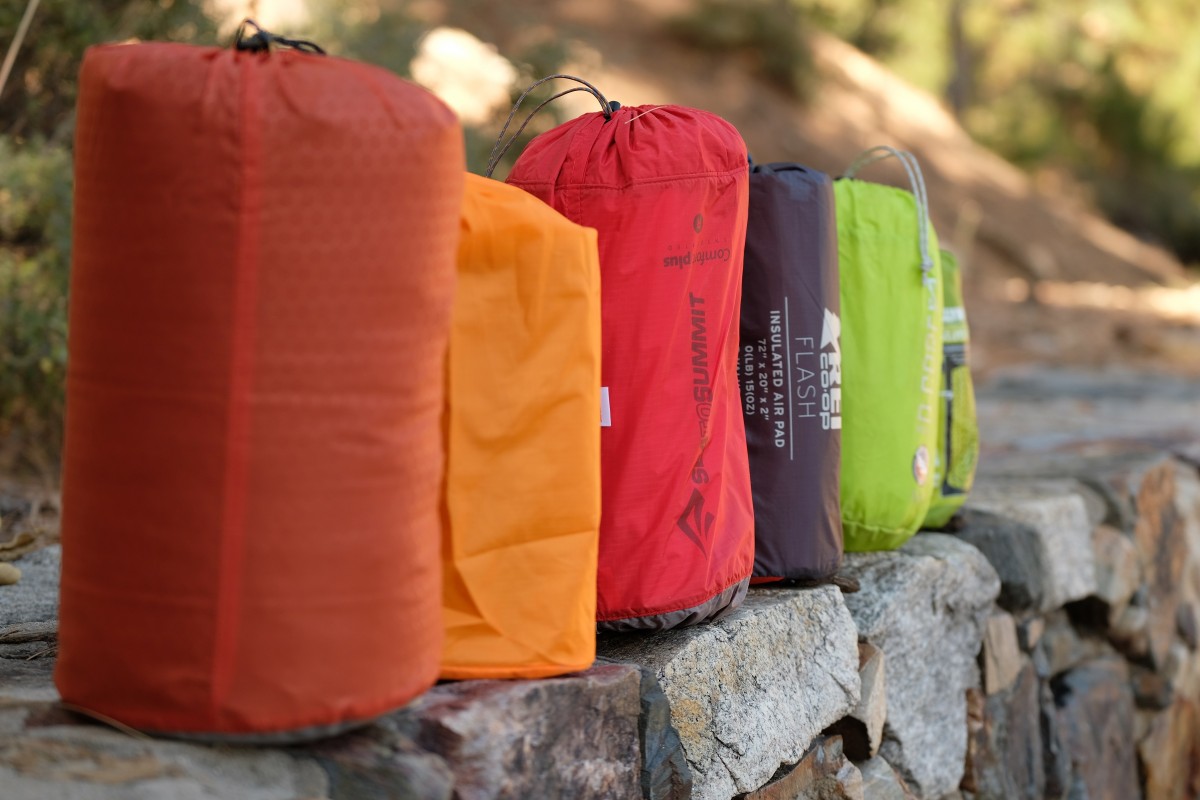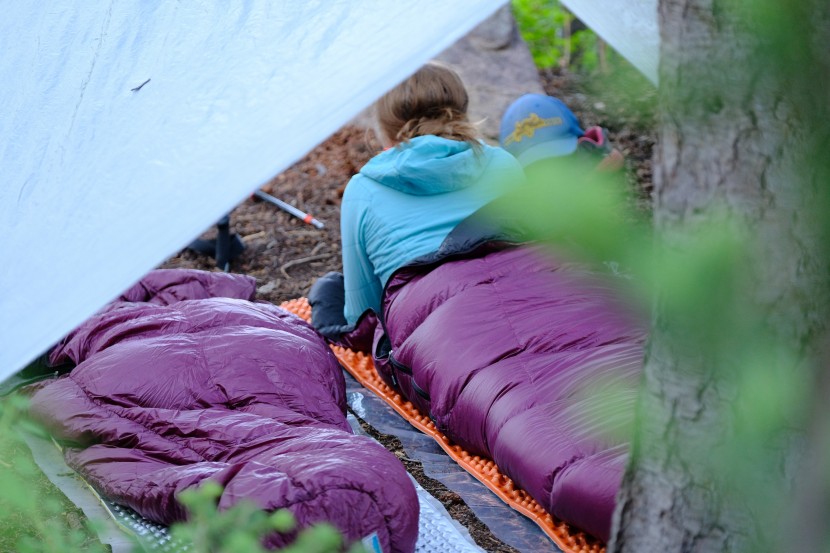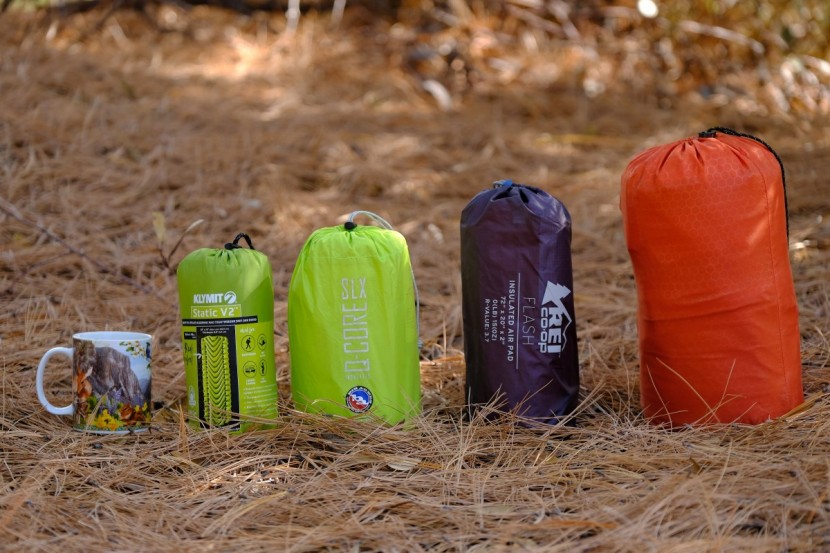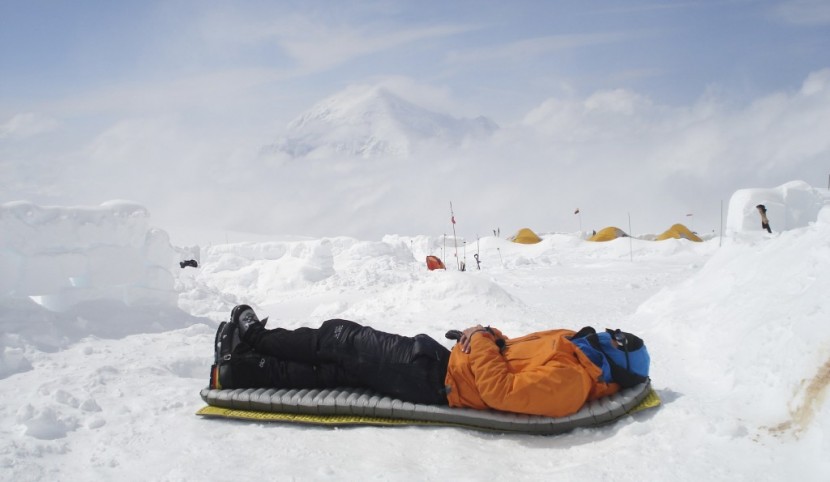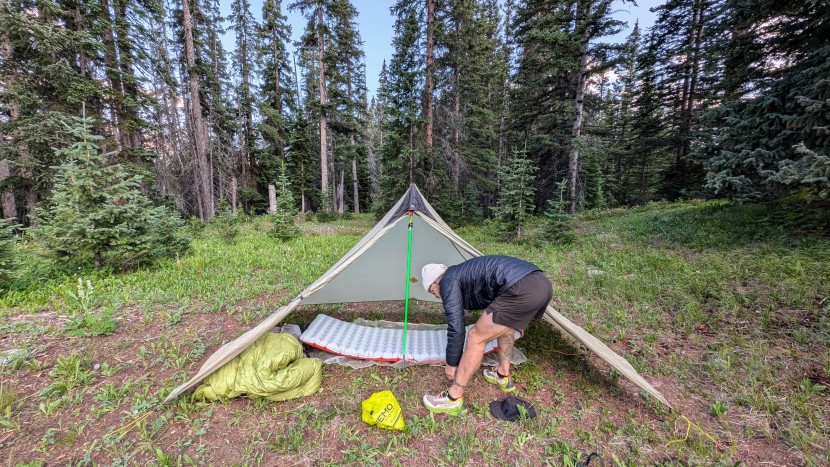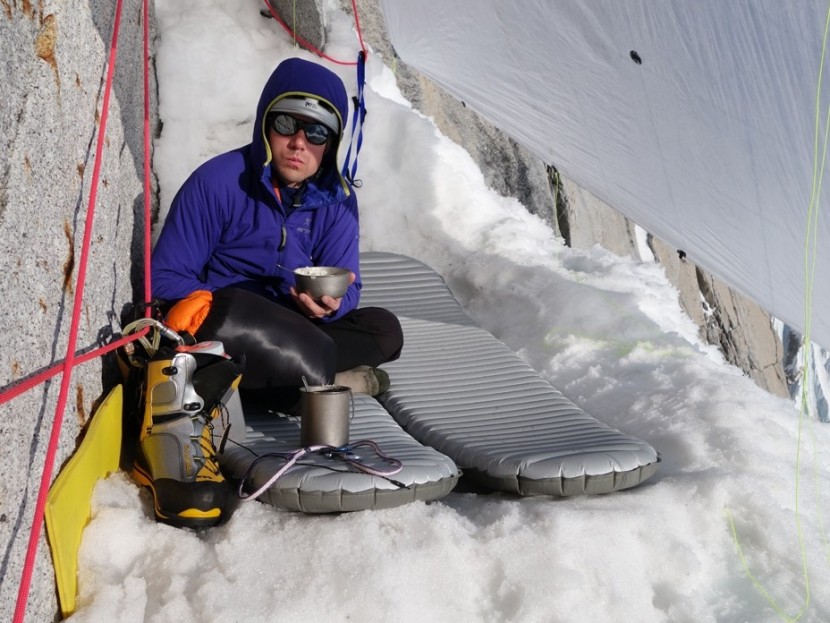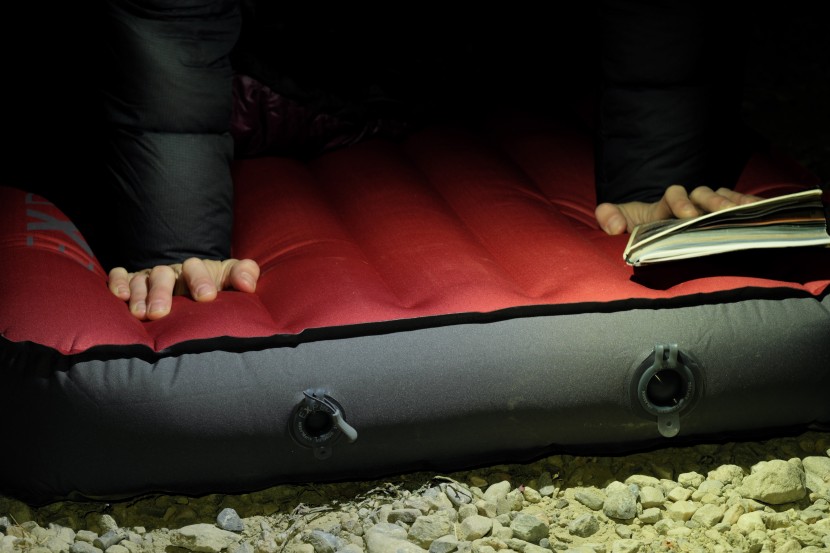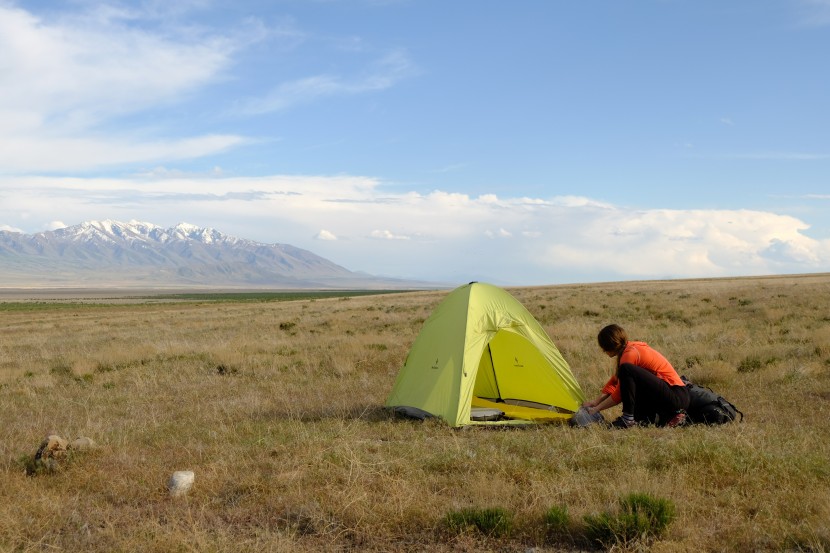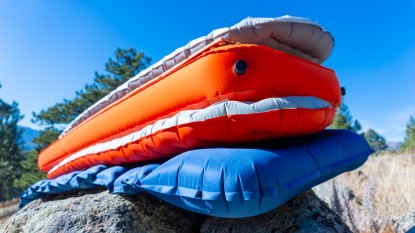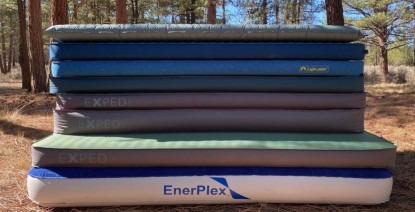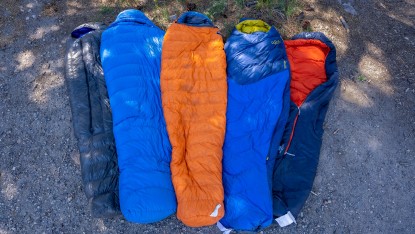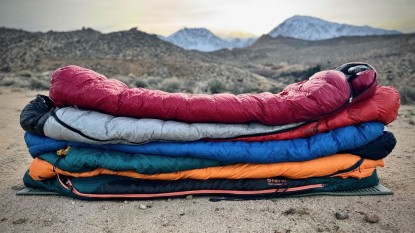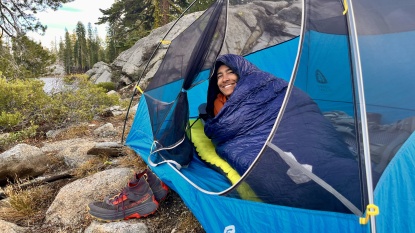Types of Sleeping Pad Construction
Backpacking sleeping pads come in three different flavors: closed-cell foam, self-inflating, and air construction. Closed-cell foam is pretty “old school.” Self-inflating is also relatively old school, but slightly more modern than closed-cell foam. Air construction is the newest, it has almost completely taken over the sleeping pad market. Each pad design has specific areas where it performs better than the other types. In some cases, you can use these pads in conjunction with each other as well.
Self-inflating
These products use an open-celled foam (like a sponge) sandwiched between two pieces of fabric. They have an air valve, which you open to let the pad “self-inflate.” When the valve is open, the foam expands and inflates the pad. The foam also traps air and retains heat. A new pad usually takes around five minutes to inflate, but old ones with compressed foam will take longer and more breaths from you to fully inflate. Remember that “self-inflating” is a bit of a misnomer, as all these pads need a few breaths to reach optimal firmness after the foam has expanded. It's best to store this type of pad semi-inflated and not compressed to extend the life of the foam.
Cons: Less durable than foam, less comfortable than air construction, can be pretty bulky
Closed Cell Foam
Closed-cell foam pads are probably what the general public thinks of when you say you're going camping. These classic camping mats are nowhere near as comfortable as inflatable air-construction pads for some obvious reasons. They are constructed of a thin foam layer, often with heat-reflective material to add additional insulation. One huge advantage closed-cell foam pads have is the overall durability. Since there is no vulnerable air chamber, these pads won't pop, leaving you with no padding to sleep on. These pads are generally very light and are a perfect solution to add additional insulation to an inflatable sleeping pad.
Cons: Bulky, uncomfortable, often difficult to brush off snow and dirt
Air Construction
“Air Construction,” or inflatable sleeping pads, have taken over the backpacking pad market. There are hundreds of different models that fit this description. These pads are generally plush and light. But they vary widely in insulation levels, from those capable of insulating you from snow underneath to those only appropriate for summer camping. While many of us remember sleepless nights camping in the early 90s on closed-cell foam pads, now we can get some sleep in the great outdoors. At their core, Air Construction pads are thin laminated fabrics filled with air, giving the user variability in pad firmness and much-needed loft above the hard ground and debris that previously caused some long nights.
Cons: Not as durable as foam, often take a while to set up, sometimes feel bouncy
Prioritizing Your Needs
There are a mind-boggling number of pads out there today, and having a general idea of your priorities will help you find the one best for you. Our backpacking sleeping pad review breaks down each attribute represented by sleeping pads and which pads top each category. These categories are comfort, weight, warmth, packed size, and quality of construction. All pads perform better in some categories and worse in others. Knowing your targeted climate and intended activity will help you zero in on which has the right combination for you.
Comfort
Besides warmth, comfort is the most important reason to buy a sleeping pad. And if you camp exclusively in warm climates, comfort is the only reason to buy one. We think pads with smooth surfaces are more comfortable than deep baffles. Pads that are two or more inches thick are the most comfortable because they make the uneven ground feel less bumpy. Deep in the backcountry, we like a pad that can turn a pile of pine cones or grass clumps into a cloud-like mattress. We find that self-inflating pads typically feel more stable than air-construction pads but often don't provide as much cushion. Overall, we think air-construction pads are the most comfortable. That is, until you compare them to The Best Car Camping Mattress.
Weight & Packed Size
The further you plan to hike daily, the more important weight becomes. Consider for a moment that you're working out at the gym. Adding five pounds of weight might not be a big deal if you're only doing five reps. But if you're going for 50 reps, that five-pound increase makes a significant difference. Reducing weight is important if you plan on pushing yourself to your limits. That said, not everyone will place the same importance on weight reduction. Comfort, warmth, and price are more important metrics for many casual outdoor enthusiasts. Reducing weight almost always comes at the expense of one or more of these three things. Figuring out what is most important to you will help you make the best choice.
A small packed size helps you use the smallest backpacking backpack possible. This reduces weight and lets you carry a less bulky (and therefore more mobile) backpack. The most packable pads stuff down to around the size of a soda can.
Remember that smaller packed sizes can come at the expense of warmth and comfort. For example, a self-inflating pad will be very bulky but also very comfortable. Closed-cell foam pads don't compress as much as inflatable pads, but they're durable enough to lash to the outside of your pack without worrying. While they are physically quite bulky, CCF pads don't take up any internal volume. In this way, foam pads could be considered the most space-efficient if you don't mind having them strapped on the outside of your pack. The most significant downsides to placing your pad outside your pack occur when bushwhacking through dense vegetation, scrambling through chimneys, or hauling your backpack up short rock sections.
Warmth
In cold climates, warmth is the most important reason to bring a sleeping pad. Your pad is just one integral component of a much broader sleep system designed to keep you alive and warm. Understanding this is critical to tailoring your set-up to be as lightweight and warm as possible.
Consider what kind of shelter you'll sleep in the most. A double-walled tent or properly made snow cave is vastly warmer than an open bivy or ultralight shelter. Moving past your shelter choice, the next two things that keep you warm and comfortable at night are your sleeping pad and sleeping bag. People often blame their sleeping bags for cold, sleepless nights when their pad was to blame! Obviously, you need a good sleeping bag to stay warm. But don't think for a second that your pad isn't just as important — the ground can zap your heat faster than the air above you.
Furthermore, consider what surfaces you're likely going to sleep on (ice, dirt, snow, rock), what the ambient temperatures are, how much of your body will be contacting your sleeping mat (side sleeper or back sleeper), and how inflated your pad is (e.g., firmness vs. softness).
If you frequent cold environments, buy a pad with the highest R-value possible. A closed-cell foam pad paired with a low R-value inflatable pad is a good way to level up the warmth of your sleeping pad without buying the warmest pad possible. For many, the two-pad combo is an excellent option because it is usually more affordable than a high R-value pad and will be lighter in the summer when the foam pad is unnecessary.
Warmth Basics
Before we get too deep into the physics of sleeping pads, we must reiterate that cold is nothing more than the absence of heat and that heat involves the transfer of energy from warmer objects to colder objects. Got it? Great!
Now, let's move on to three primary ways we lose heat when sleeping: conduction, convection, and radiation. If you don't remember thermodynamics from school, know that heat transfer via conduction involves touching something colder (for example, touching metal in the snow). Convection involves fluid or gas moving over you (for example, getting chilled from the wind). Radiation is heat transferred via electromagnetic waves to objects around you. The temperature difference between you and your surroundings dictates how much heat you lose by radiation. At temperatures below -20º F, heat loss through radiation becomes significant.
Understanding R-Values
Sleeping pads made by reputable manufacturers have an R-value that relates to how well the pads resist the flow of heat. The higher the R-value, the warmer the pad will feel. The equation is linear, meaning that a pad with an R-value of 3 is three times better at resisting heat loss than a pad with an R-value of 1.
At this point in our ramblings on sleeping pad insulation, we previously would have complained about the lack of industry standardization with R-values. We would have said to take the company's provided values with a grain of salt. Perhaps the best thing that happened in 2020 was the adoption of ASTM (American Society for Testing and Materials) F3340-18 standardized R-values! (Insert applause emoji here). This means that across the outdoor industry, pads with listed R-values are tested via the same ASTM methods. This means that those R-value numbers are quite reliable.
Inflation Level
According to an experiment performed by Backpacking Light, the level of inflation significantly affects the real-world R-value of a sleeping pad. The more air you have in the pad, the warmer it is. This also means you'll be sleeping on a very firm mat, which many people will find uncomfortable.
Sleep Surface
An often overlooked component of staying warm while sleeping out is what surfaces are best for heat retention. If your choice is between snow and rock, it's better to sleep on snow. Most of that snow is air, which is an excellent insulator, whereas rock is incredibly good at transferring that warmth in a hurry. Generally, if overnight temps have been below freezing, it is likely better to bivy on snow than rock. No matter what season, if pine boughs or soft leaf litter is an option, these soft surfaces can yield comfortable and warm places to sleep.
Supplementing an Air Mattress with a Foam Pad
Adding a closed-cell foam pad beneath your inflatable sleeping pad will add extra puncture resistance and boost your sleep system's R-value. This is an extremely functional way to add versatility to your sleeping pad. This method also equips you with two separate pads that can be used individually for ultralight missions or warmer days when the boosted R-value isn't needed.
Warmth Conclusion
At the end of the day, our experience has taught us a few simple rules of thumb when choosing a sleeping pad for warmth. First, you need to think of your pad as part of your sleeping system. If you skimp on your pad's warmth, use a warmer sleeping bag, and vice versa. Second, we have found that pads with R-values between 2 and 3 generally work well for three-season use but should be supplemented with a foam pad for use in the winter, where an R-value of around five or above is ideal. Pads with R-values lower than 2 are great for summer, but you may want to supplement them with a closed-cell foam pad on colder nights in the spring and fall. Third, know how your body works! If you know you're a cold sleeper, do yourself a favor and opt for a warmer sleeping pad.
Inflation
It's no surprise that self-inflating mats are the easiest to inflate. They are filled with open-celled foam that does most of the work for you. After letting the pad sit for a few minutes, you'll need to top it off with a couple of puffs.
Inflatable sleeping pads somewhat easy to inflate. While some have included pump bags, which often make inflation super easy, others don't and require some serious lung labor. Don't dismiss the usefulness of a quality pump bag when looking at sleeping pads. Pump bags also eliminate the moisture buildup inside air pads, which can eventually cause mildew or mold growth.
Durability
The advent of inflatable sleeping pads brought with it a significant concern. The overall durability of these air-filled pads is critical, as is your technical ability to patch them in a pinch. All pads we tested came equipped with a patch kit, and most pads came with a warranty, something worth looking into before making a purchase. The material thickness is measured in “denier.” The higher the number, the thicker the material. The highest denier we have seen in backpacking sleeping pads is around 75D, and 15D is the thinnest.
Conclusion
Hopefully, we've demystified the saturated sleeping pad market enough to help you on your quest to find the right product. Whether you're looking for a pad that expertly balances all of the attributes mentioned above into a tidy package or perhaps are looking for the absolutely lightest and smallest package out there, numerous options will make your next adventure memorable—in a good way.

